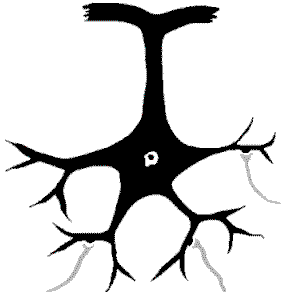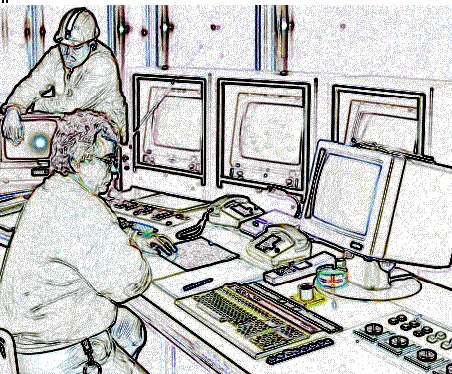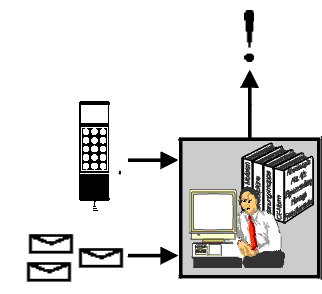The Idea of a Synaptic
Office in Neural Companies
|
|
|
Although
the brain’s working cannot be reduced to any one
principle alone, the connecting points between different
nerve cells, called synapses, seem to play a major role
in the brain’s operating system. The basic
information processing units of the brain are single
nerve cells, called neurons. Each  neuron has one outgoing nerve fibre
called the axon. This may bifurcate a number of times. It
is along the axon alone that the neuron can send signals
to other neurons. Another structure stretching out from
the neuron`s body is called dendrites. Dendrites usually
have a tree-like shape and this is where ingoing signals
from the axons of other neurons are received through.
Now, each signal that passes from the axon of one neuron
to the dendrite of another neuron has to cross a
physically visible structure called the synapse. The
likelihood, however, with which an ingoing signal will be
transmitted across the synapse is influenced by the
synapse’s momentary internal structure. The synapses
readiness to pass on signals is called synaptic
conductivity. Inside the neurons body, called the soma,
the ingoing signals are processed in a way unknown. But
most scientists would agree that the outgoing signal of a
neuron is significantly influenced by its input. neuron has one outgoing nerve fibre
called the axon. This may bifurcate a number of times. It
is along the axon alone that the neuron can send signals
to other neurons. Another structure stretching out from
the neuron`s body is called dendrites. Dendrites usually
have a tree-like shape and this is where ingoing signals
from the axons of other neurons are received through.
Now, each signal that passes from the axon of one neuron
to the dendrite of another neuron has to cross a
physically visible structure called the synapse. The
likelihood, however, with which an ingoing signal will be
transmitted across the synapse is influenced by the
synapse’s momentary internal structure. The synapses
readiness to pass on signals is called synaptic
conductivity. Inside the neurons body, called the soma,
the ingoing signals are processed in a way unknown. But
most scientists would agree that the outgoing signal of a
neuron is significantly influenced by its input. |
|
 a neural company as such a neural company as such more pictures, drawings and animated.gifs about
neural companies more pictures, drawings and animated.gifs about
neural companies
 In the USA there is a company called "Synaptic
Communications Inc" In the USA there is a company called "Synaptic
Communications Inc"
|
| If you
appreciate the fact that an ordinary neuron is connected
to about 10.000 other neurons, this fact can be
formulated as follows: In any given situation, a
neuron’s output is at least partly determined by the
synaptic conductivity of its synapses. Weighing ingoing
signals according to the current situation seems to be
one key to intelligent information processing. We must,
therefore, suspect some intelligent mechanism regulating
synaptic conductivity. |
|
|
| The
strength of this principle is proven by the widespread
success of „neural networks“. These computer
programmes exploit the mechanism of altering synaptic
conductivity. By the use of more or less sophisticated
learning algorithms, synaptic conductivity within a
network of neurons is so manipulated that the
network’s overall output increases in quality during
a session of learning sets. |
|
|
| Let us now
turn to human information workers within an ordinary
organization like a company and see the similarities. 
Figure 1: Typical working place at the
end of the 20th century
The picture above shows quite an ordinary working
place in the control centre of an industrial plant. Via
the monitors and through the telephones and notes lying
about on the desk, the operator is linked to vast
ressources of information. Long lists of telephone
numbers, shift plans, process data showing temperatures
inside tanks, rotational speeds of enginges, electrical
currents and voltages, CH4-contents of analyzed coal,
maps of the plant’s premises, plans of electrical
intallations, flow charts etc.
|
|
|
| In case of
an accident, the speed and quality of the operator’s
decisions and instructions given to other people „on
the spot“ will largely depend on how fast he can
access relevant information. This is true of any
situation where human attention and time for information
retrieval are limited ressources. |
|
|
| Technologies
for user- and case-sensitive data-presentation are one
key-focus of groupware and knowledge-management systems
being developed at present. They all aim, more or less,
at sensibly modifying the attention a certain piece of
information can attract from a user in a given situation.
To revert to the model of neurons, they modify synaptic
conductivity between providers and potential recipients
of information. If you place an important note right on
the desk of a colleague instead of sending it through the
company snail-mail system you are increasing the synaptic
conductivity between the note’s content and your
colleagues attention. 
Figure 2: pieces of information around
a typical office worker
The picture above suggests many ways in which the
likelihood of a certain piece of information 1 to 8
reaching the workers attention can be modified quite
easily by placing at another location.
 And the same thing happens when you are
surfing the internet using a commercially oriented
browser. By constantly monitoring your interests, the
browser may be able to suggest links, banners and tickers
that are most relevant to you in such a way as to
increase the likelihood that the linked contents will
pass through the monitor or loudspeaker straight into
your brain. Even the simple rules governing the right to
speak between different people in a company fall in this
case: the higher up on the hierachical ladder you are,
the greater is your privilege to interrupt lowers in
their conversation to put in what you have to say. This,
obviously, increases the likelihood with which superiors
can get their messages across. And the true value of a
good secretariat is to filter and weigh ingoing
information in such a way, as to best suit the needs of
the superior. For an unimportant and unpopular colleague,
the synaptic conductivity of the secretariat may be near
nil whereas an important customer may gain direct access
to the boss in the same circumstances. And the same thing happens when you are
surfing the internet using a commercially oriented
browser. By constantly monitoring your interests, the
browser may be able to suggest links, banners and tickers
that are most relevant to you in such a way as to
increase the likelihood that the linked contents will
pass through the monitor or loudspeaker straight into
your brain. Even the simple rules governing the right to
speak between different people in a company fall in this
case: the higher up on the hierachical ladder you are,
the greater is your privilege to interrupt lowers in
their conversation to put in what you have to say. This,
obviously, increases the likelihood with which superiors
can get their messages across. And the true value of a
good secretariat is to filter and weigh ingoing
information in such a way, as to best suit the needs of
the superior. For an unimportant and unpopular colleague,
the synaptic conductivity of the secretariat may be near
nil whereas an important customer may gain direct access
to the boss in the same circumstances.
|
|
 neural offices in a networked company neural offices in a networked company |
| So here we
have one (no more!) basic mechanism of neural
intelligence to build on: the weighing of different
sources of information. And although the weighing of
information inputs can occur in many ways without the aid
of computers, this paper will concentrate on digitalized
communication and knowledge management. Thus, the
classical model of communication including sender,
recipient, content and medium of information transmission
is slightly modified to bring it nearer to the neuron
model of real brains: 
Figure 3: the idea
of an organizational neuron
|
|
|
|
|
|
 |
 |
| one level up |
top
level |
|
|

Kontakt
|